ESA Interface Modules for ESA Trainers

ESA IF-8ADC12M
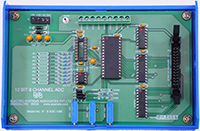
8 Channel 12-Bit ADC Interface
This interface is based on Analog Devices 12-bit, 10l-lsec sampling ADC, AD1674 which has a built-in sample and hold amplifier too. The ADC accepts Unipolar (0-1 OV) or Bipolar (± 1OV or ±5V) signal inputs. Provision for an optional 8 channel multiplexer, ADG 508. The channels can be configured to accept current (4-20mA) or voltage signals, the interface has 9 pin terminal strip to feed the analog voltages. This interface allows the user to become familiar with various applications of high precision ADCs and analog multiplexer.
ESA IF-16ADC8
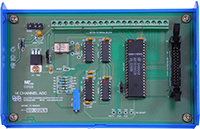
16 Channel 8-Bit ADC Interface
This interface provides 16-Channel, 8-bit ADC, based on ADC 0816 - a 16 channel 8 bit data acquisition device. Provision is made for on-board reference voltage generation using precision voltage regulator LM 723. The interface has 20 pin terminal strip to feed in the analog voltages. The input signal voltage range is 0-5V.
ESA IF-DADC
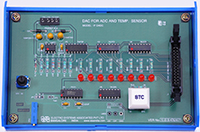
DAC for ADC and Temperature Sensor Interface
This interface consists of an 8-bit D/A converter (DAC) and a comparator. User can control the input to the DAC through a port (the port output is latched and presented as input to the DAC). The DAC output and Analog input are fed to a comparator whose output can be monitored through another port line. A key, whose status can be read through a port line, is also provided. User software can read this key status to determine when to start the conversion. This interface allows the user to implement A/D conversion using DAC through successive approximation technique or counter technique. Also provided is a simple temperature sensor simulator consisting of a TTL monoshot, allowing the user to employ a thermistor to convert a physical parameter like temperature to its equivalent digital code.
ESA IF-DDAC
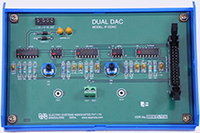
Dual DAC Interface
This interface consists of two 8-bit D/A converters whose current outputs are converted to voltage outputs using operational amplifiers. These voltage outputs are available to the user. The inputs to the DACs can be controlled through two ports. A sample program is provided with the interface to generate a triangular waveform. The waveform can be observed on CRO. The user can write separate programs to generate other wave forms like sine wave, square wave, etc.
ESA IF-DSADC
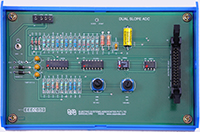
Dual Slope ADC Interface
This interface consists of an integrator and a comparator. A port line can be used to control a CMOS analog switch to reset the integrator, another port line can be used to control another CMOS analog switch to allow the integration of an analog input (the duration of integration is controlled by user software) and yet another port line can be used to control another CMOS analog switch to allow the integration of standard reference Voltage (the duration of which can be measured by user software). The integrator output is fed to a comparator and the comparator output, in turn can be sensed through a port line. Offset trimming provision is available for the integrator and comparator. This interface helps the user to understand the principle of Dual Slope.
ESA IF-ELV
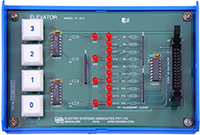
Elevator Interface
This interface simulates the control and operation of an elevator. Four floors are assumed and for each floor a key and corresponding LED indicator are provided to serve as request buttons and request status indicators. The elevator itself is represented by a column of ten LEOs. The motion of the elevator can be simulated by turning on successive LEOs, one at a time. The delay between turning off one LED and turning on the next LED can simulate the "speed" of the elevator. User can read the request status information through one port, reset indicators through a second port and control the elevator (LED column) through a third port. The interface allows the user to write software for simulating the operation of elevator. The software exercises could include priority schemes, different service schemes, etc.
ESA IF-KBD-DISP
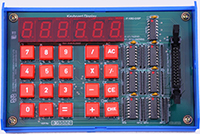
Calculator Keyboard Interface
This keyboard display interface provides a calculator style keyboard with seven segment display. It consists of the keys 0 to 9,. =, +,-, x, /, %, AC, CE, CHK and six 7-segment displays. The 20 keys are arranged in a 4x5 matrix (each row has 5 keys). This interface allows the user to study a number of techniques generally used in calculator keyboard interfacing. User can write programs to gain a good understanding of keyboard display, arithmetic group of processor instructions by implementing the calculator functions (+,-, /, =, %, etc.).
ESA IF-KBD
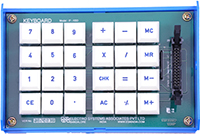
Keyboard Interface
This interface provides a calculator type keyboard consisting of the keys 0 to 9, +,-, x, /, =, %, AC, CE, etc. These keys are arranged in 2 groups of 3x4 matrix. The row lines can be driven by a port and the column lines can be sensed through another port. The interface allows the user to study a number of techniques generally used in keyboard interfacing. User can write programs for software debouncing of key closures, two key lockout, keyboard encoding and parsing, etc., to gain a good understanding of keyboard interfaces. User also learns how to use arithmetic group of processor instructions by implementing the calculator functions (+,-, x, /, =, %, etc.).
ESA IF-LC

Logic Controller Interface
This interface consists of eight TTL buffered outputs and eight TTL buffered inputs. The logic state of each input/output is indicated by a corresponding LED (ON/OFF). The inputs can be read through one port and the outputs can be controlled through another port. The inputs and outputs are brought to berg-pins. Two Dip-Switches SW1 and SW2 are also provided. SW1 is used to connect the output status to the corresponding input line when the switch is ON. SW2 is used to set different logic states by setting the switch to ON (or) OFF This interface allows the user to perform experiments to understand some of the basic programming techniques involved in a logic controller. The software exercises could include combinational controllers, sequential controllers, programmable counters, etc.
ESA IF-MTG
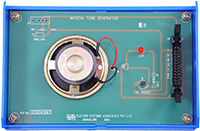
Music Tone Generator Interface
This interface consists of a transistor and a speaker. The transistor is driven by a port line and the transistor in turn amplifies the signal and drives the speaker. By controlling ON/OFF periods of the port line through software, user can generate the required musical note. Sample programs are provided to generate a variety of musical notes.
ESA IF-TRL
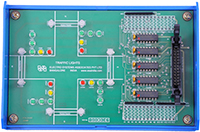
Traffic Light Interface
This interface simulates the control of traffic lights at a traffic island. In each of the four directions (North, South, East, and West) LED indicators (Left, Right, Straight, Amber, Red and Pedestrian Red/Green) are provided. These 24 LEOs are controlled through 24 port lines of 8255. This interface allows user to write software for simulating a variety of traffic situations. Sample programs supplied with this interface will illustrate the traffic movement sequences in a traffic island.
ESA IF-RTC
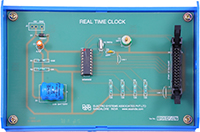
Real-Time Clock Interface
This interface is based on MSM5832 real-time clock/calendar (RTC) chip which can be interfaced to the programmable peripheral interface 8255A. The RTC is backed up by a battery, allowing it to retain all the RTC information even if the power is switched off. This interface allows the user to study the application of real-time clock in microprocessor based systems.
ESA IF-STEP
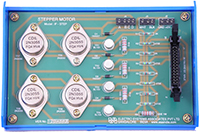
Stepper Motor Interface
This interface consists of a stepper motor (+12V-+5V DC, 3 Kg.cm torque), Power Supply and required driver circuitry along with the necessary software to control the operation of the stepper motor. This interface permits ON/OFF control of the individual coils of the stepper motor at varying speeds in either direction.
ESA IF-DIS
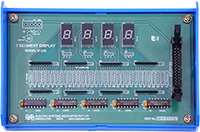
Display Interface
This interface provides a four digit 7-segment display driven by the output of four cascaded shift registers. Data to be displayed is transmitted serially (bit by bit) to the interface. Each bit is clocked into the shift register by providing a common clock through a port line. Thus one port line provides the data and another port line provides the clock. This interface allows the user to study 7-segment display control techniques, code conversion methods, etc. The software exercise could include procedures for table lookup, a variety of bit manipulation operations, etc.
ESA IF-OPTIN
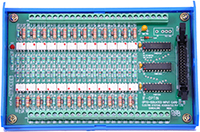
OPTO Isolated Input Interface
The opto isolated input card is a general purpose interface for microprocessor based systems, PC compatibles or any other electronic circuitry where absolute electrical isolation is required between an external signal and the system for the safe operation of the system. The opto isolated input card converts a DC input voltage into a TTL-Level signal that can be read by the interfacing system. This unit allows the user to connect 24 input signals. It provides convenient interface for various applications like opto isolated 12C, opto isolated odometer input signal, in laser technology, etc.
ESA IF-OPTOUT

OPTO Isolated Output Interface
The opto isolated output card is a general purpose interface for microprocessor based systems, PC compatible or any other electronic circuitry where absolute electrical isolation is required between the system and the external circuit. This unit allows the user to drive 24 opto isolated outputs from a microprocessor based system or any other TTL circuit. It provides convenient interface for various applications like microcomputer based industrial control, etc
ESA IF-RLYO
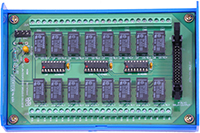
Really Output Interface
This interface module is used as a switch to connect to an external circuit. This interface consists of 16 relays operated at +5/+12V DC, the inductive coupling between relay coil and contacts provides electrical isolation between the controlling system and the contacts (potential free). Relays are ideally suited for controlling everything from lights and motors to telecommunication, audio and video signals. Some relays can be used for switching radio frequency signals. Microprocessor based relays combine protection with control, data acquisition and networked communication.
ESA IF-TXDR
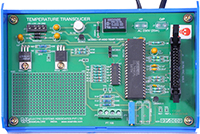
Temperature Transducer Interface
This interface is used to control the temperature by interfacing a Resistance Temperature Detector (RTD) with a microprocessor. The RTD converts change in temperature to change in Resistance. The change in resistance is converted into change in voltage using a resistance bridge. By using ADC the voltage is converted into digital form and interfaced to microprocessor.
ESA IF-DC MOTOR
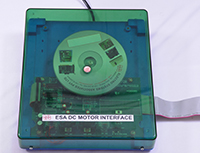
DC Motor Interface
The DC motor used in this interface module is of rating +12V at 250mA. This interface is used to control the speed of the motor. The pulse width modulation technique is used to vary the speed of the DC motor. The frequency of the pulse is 100 Hz. Keeping the frequency constant, the width of the pulses is used to change the speed. The ramp and pedestal technique is used to change the pulse width and there by the speed. DC motors can be used in various applications like robots, sewing machines, grinders, lathe, precision high speed drilling and milling spindles, etc.
ESA IF-LCD
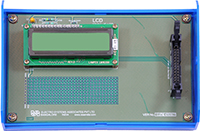
16x2 LCD Interface with Backlit
LCD modules are widely used in areas where information is conveyed for viewing. They can be seen in calculators, mobile and cellular phones, pagers and other electronic products. The interface is built around 16x2 (sixteen character per line and two lines) alphanumeric LCD module. This can be directly coupled to the programmable peripheral interface 8255 on any of the trainers. This present interface module allows the user to become familiar with the techniques of using the LCD module.
ESA IF-HEX

4X4 Matrix HEX Keyboard Interface
This interface consists of 16 keys from (0 to F) arranged in a matrix of 4 columns and 4 rows with a switch at every intersection. The controller scans the keys. If a key has been pressed, the controller determines the row-column combination of the key.
ESA IF-I2C
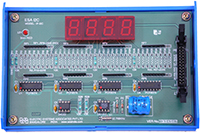
Inter –Integrated Circuit Interface
This I2C interface consists of Real-Time clock, 2-wire serial EEPROM, four 8 bit I/O expanders which drive four 7 segment displays. All the six I2C peripherals communicate with its master on the same I2C bus. User can develop the programs for RTC and display the clock on the 7 segment displays. EEPROM can be used to save non volatile variables. User can use on chip I2C controller or generate the I2C protocol using GPIO.
ESA IF-ZIGBEE
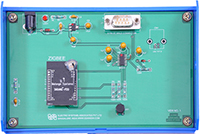
ZIGBEE Interface
ESA ZIGBEE interface module can be easily interfaced to any serial port device/equipment for wireless communication. In this interface it makes use of the Tarang ZigBee Transceiver module. ESA ZIGBEE Interface supports multiple network topologies such as point-to-point, point-to-multipoint and mesh networks. User can select and program in any network topology.
ESA IF-8251/8253*
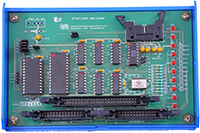
Intel 8251/8253 Study Card Interface
This study card is designed to explain all the features of Intel 8251USART and Intel 8253 Programmable Interval Timers to work with Intel microprocessor 8085, 8086, 8088 and 8051. Intel 8251 operates in asynchronous mode for serial data communication. The RS232 serial data output is available. The timers of 8253 can be programmed - Timer 0 is programmed to generate the baud clock for 8251. Timer 1 and Timer 2 can be programmed as an interval timer or an event counter.
ESA IF-8255*
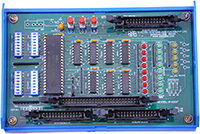
Intel 8255 Study Card Interface
This study card is designed to demonstrate different modes of operation of Intel 8255Programmable Peripheral Interface to work with Intel microprocessor 8085, 8086, 8088 and 8051. It has four 8-way dipswitches to control the input lines of 8255 Port A and Port B lines. Three lines of Port Care controlled using push buttons. The port lines statuses are displayed using 8 Red (Port A), 8GREEN(Port B) and 5 YELLOW LED (Port C).Push buttons S1, S2 & S3 are also used to stimulate STB or ACK signals.
ESA IF-8259*
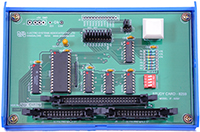
Intel 8259 Study Card Interface
This study card is designed to demonstrate different modes of operation of Intel 8259 Programmable Interrupt Controller to work with Intel microprocessor 8085, 8086, 8088 and 8051. The interrupts are configured using onboard 4-way dipswitch to select the required interrupt on Intel 8259. The push button switch activates the selected interrupt. Interrupts to Intel 8259 can also be given from external sources through a connector. A jumper is to select the source of interrupts – onboard or external.
ESA IF-8279*
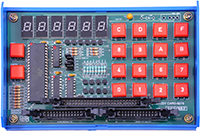
Intel 8279 Study Card Interface
This study card explains all the features of Intel8279Keyboard/Display Controller. Study card provides 6 numbers of 7-Segment display and 4x4 matrix Hex Keypad to work with Intel microprocessor 8085, 8086, 8088 and 8051. The keypad includes shift and control keys. It supports encode and decode modes of operation through on-board jumpers.
